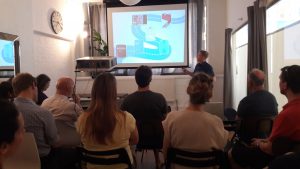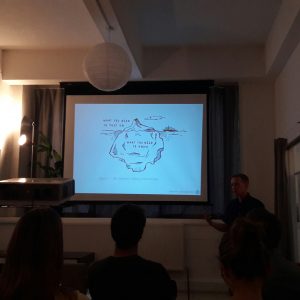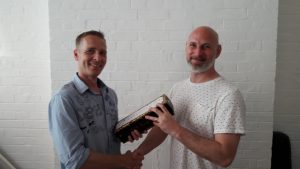The usefulness of the cup is in its emptiness – Bruce Lee
These are notes from Morten Hoegh’s ‘Talking Pain out of Patients’ seminar – 25th May 2017, Le Beau – Scrutton Street
“Pain is about the individual. It is person specific. We have our own individual thresholds”.
Humans are complex. The complex situation also makes it very individual. To understand what will influence one person and not another is to understand that person’s life. For example, a wrist sprain to a musician maybe more painful than say to an office worker.
The level of threat changes according to the person’s life situation.
Likewise, the solution will also change. What will work for one person at one time may not work at another. So the issue is intra-person as well as inter-person.
Metaphor: Pain is like a ‘baby’.
How do you stop a baby crying? You try something e.g. feed them. Maybe it works! Pain shares a similar characteristic – we try something. It seems to work. But take care not to infuse causality. Things work in general but we don’t really understand why!
Explaining pain science ≠ Explaining why I hurt
We know that tissue damage does not equate to the level of pain. Lower back pain is a primary example of how this phenomena can exist. People can experience pain in the back whilst there is no evidence of any facet, spine or tissue damage in the area. Likewise people can be pain-free despite a scan revealing serious debilitation which according to medical science would warrant attention. (We attribute this to adaptation).
The question is: What role does ‘Pain Science’ play?
Many things in life just work and we don’t really know why. However we (as humans) seem to want to attribute meanings and causality. That’s a dangerous step because there is no science to support this.
In principle, if we have a target there are often many ways to achieve the target. Because we try one route and we reached our target should not obscure or cloud our thinking that an alternative and perhaps more efficient method also exists.
There are many things that we can do to optimise our chances of success but fundamentally be aware that we still don’t know how things work! The role of Pain Science is to be part of the effective strategy.
We can have an educated guess or refer to evidence based practice or try to use science. However, some techniques fall outside this remit simply because they are just too difficult to measure or replicate to meet the consistency requirements of a) the scientific community or b) to be commercially viable to mass market.
“The usefulness of the cup is in its emptiness” – Bruce Lee
A piece-meal approach to recovery is likely to offer a limited response in effective resolution. The virtue of ‘Totality’ in Bruce Lee’s quote is that the recipient, like an empty cup, is able to receive the full benefit of the advice given. They will take it on and utilise the complete strategy. This may entail a shift in life patterns, eliminating certain practices, trying new ones and re-directing life goals to achieve the desired outcome. Be like water!
An example: hamstring proximal tendinopathy
The simple solution is to offer a form of hamstring rehabilitation. Initially some rest, followed by manual therapy followed by progressive exercises to strengthen the damaged area.
The alternative solution is to consider why the damage happened in the first instance. What is it about the person’s life and actions that created this outcome. Treat the person and not just the injury or pain. This of course is more complex and will need a better understanding of the individual.
Photo: Tim Beames of NOI Group presenting Morten Hoegh (blue shirt) with a speaker’s gift.



